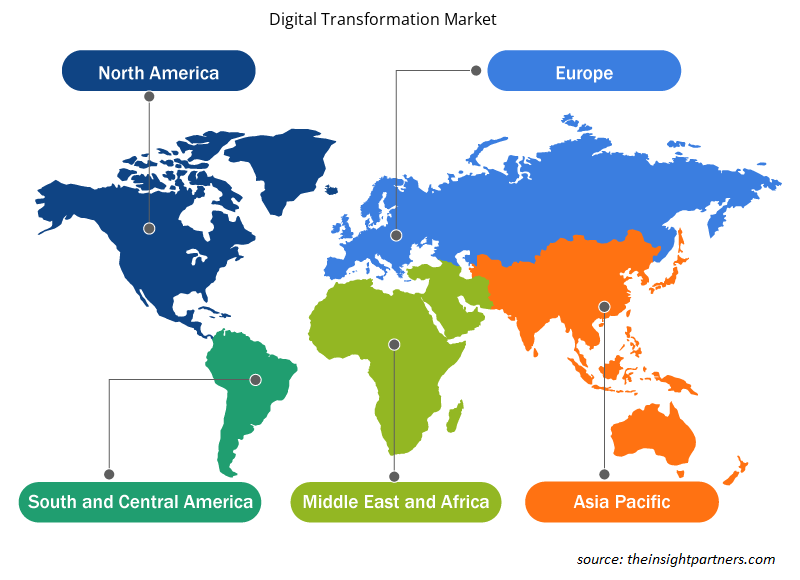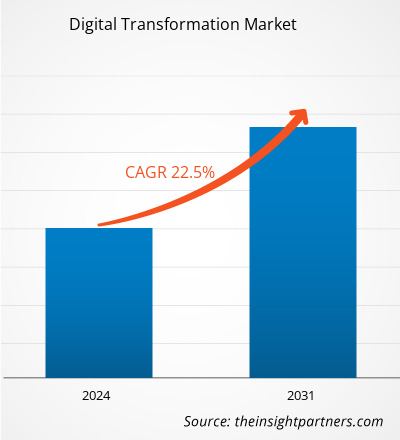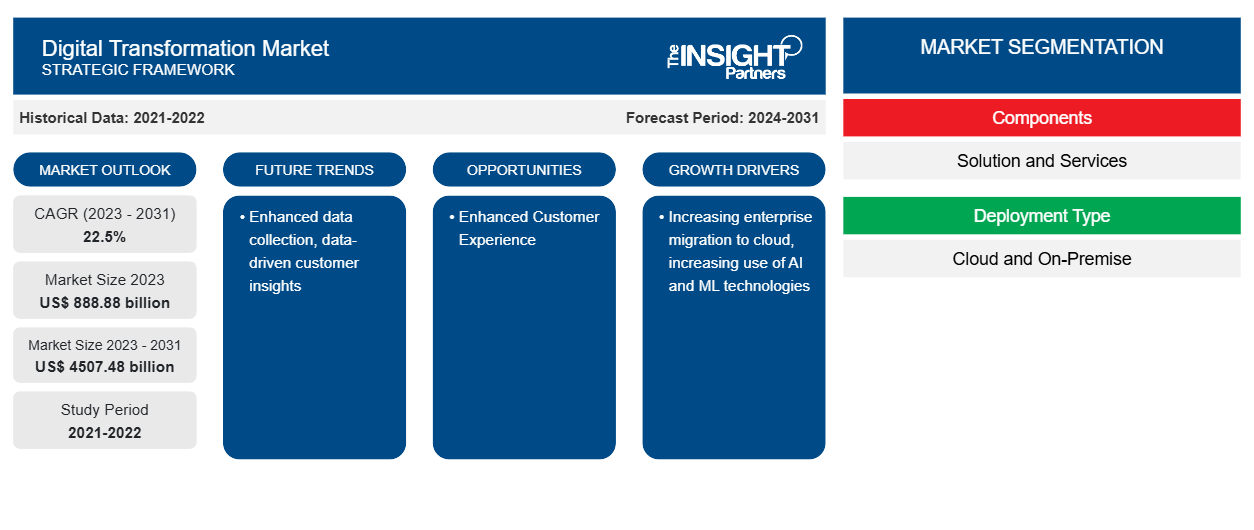Das Marktvolumen für die digitale Transformation soll von 888,88 Milliarden US-Dollar im Jahr 2023 auf 4507,48 Milliarden US-Dollar im Jahr 2031 anwachsen. Der Markt wird voraussichtlich zwischen 2023 und 2031 eine durchschnittliche jährliche Wachstumsrate (CAGR) von 22,5 % verzeichnen. Verbesserte Datenerfassung und datengesteuerte Kundeneinblicke werden voraussichtlich weiterhin wichtige Markttrends für die digitale Transformation bleiben.
Marktanalyse zur digitalen Transformation
In den sich ständig weiterentwickelnden globalen Unternehmensabläufen ist die digitale Transformation für Unternehmen unabdingbar geworden, um auf dem Markt relevant und effizient zu bleiben. Alle Organisationen, ob klein oder groß, gehen zunehmend dazu über, ihre Abläufe durch die Migration in die Cloud zu rationalisieren. Um Kundennutzen zu schaffen, müssen digitale Technologien in jeden Geschäftsbereich integriert werden. Dies treibt das Marktwachstum voran.
Marktübersicht zur digitalen Transformation
Laut den vom Weltwirtschaftsforum veröffentlichten Prognosen werden der Weltwirtschaft bis 2025 durch die digitale Transformation 100 Billionen US-Dollar zufließen. Organisationen auf der ganzen Welt haben digitale Strategien eingeführt, um ihre Erfolgsquoten zu erhöhen.
Passen Sie diesen Bericht Ihren Anforderungen an
Sie erhalten kostenlose Anpassungen an jedem Bericht, einschließlich Teilen dieses Berichts oder einer Analyse auf Länderebene, eines Excel-Datenpakets sowie tolle Angebote und Rabatte für Start-ups und Universitäten.
-
Holen Sie sich die wichtigsten Markttrends aus diesem Bericht.Dieses KOSTENLOSE Beispiel umfasst eine Datenanalyse von Markttrends bis hin zu Schätzungen und Prognosen.
Markttreiber und Chancen für die digitale Transformation
Zunehmende Migration von Unternehmen in die Cloud begünstigt den Markt
Die Cloud-Migrationsstrategie von Unternehmen kann als die Umstellung von einer Infrastruktur vor Ort auf einen virtuellen Dienst verstanden werden, der unter anderem Skalierbarkeit, Rechenleistung , Speicher und Netzwerkdienste auf Abruf bietet. In dieser digitalisierten Wirtschaft erkennen Unternehmen die Notwendigkeit von Geschwindigkeit und Kosteneinsparungen, Notfallwiederherstellung und ständiger Aktualisierung neuer Technologien. Laut einer Google Cloud Brand Pulse-Umfrage von 2022 streben rund 41,4 % der globalen Technologie- und Unternehmensführer Investitionen in Cloud-basierte Dienste und Technologien an, um sich auf dem hart umkämpften Markt behaupten zu können. Dies treibt das Wachstum des Marktes für die digitale Transformation voran.
Verbessertes Kundenerlebnis – eine Chance auf dem Markt der digitalen Transformation
Die zunehmende Welle der digitalen Transformation sollte das Kundenerlebnis verbessern, indem es nahtloser und intuitiver gestaltet wird. Dies kann durch eine Verkürzung der Reaktionszeit bei der Kontaktaufnahme mit Kunden erreicht werden. Kunden erwarten hohe Standards bei ihrer Online-Präsenz. Marken konkurrieren bei der Verbesserung des Kundenerlebnisses, indem sie erschwingliche Preise und schnelle Lieferungen anbieten. Dies ist durch die zunehmende digitale Transformation möglich geworden.
Segmentierungsanalyse des Marktberichts zur digitalen Transformation
Wichtige Segmente, die zur Ableitung der Marktanalyse zur digitalen Transformation beigetragen haben, sind Komponenten, Bereitstellungstyp und Anwendung.
- Basierend auf den Komponenten wird der Markt für die digitale Transformation in Lösungen und Dienste unterteilt.
- Basierend auf der Bereitstellungsart ist der Markt für die digitale Transformation in Cloud und On-Premise unterteilt. Das Cloud-Segment hatte im Jahr 2023 den größten Marktanteil.
- Basierend auf der Anwendung ist der Markt für digitale Transformation in BFSI, Gesundheitswesen, Bildung, Einzelhandel, IT und Telekommunikation, Logistik und Transport, Fertigung und Andere unterteilt.
Marktanteilsanalyse zur digitalen Transformation nach geografischer Lage
Der geografische Umfang des Berichts zum Markt für digitale Transformation ist hauptsächlich in fünf Regionen unterteilt: Nordamerika, Asien-Pazifik, Europa, Naher Osten und Afrika sowie Südamerika/Süd- und Mittelamerika.
Nordamerika dominiert dieMarkt für digitale Transformation. Die Dominanz der Region ist auf die Präsenz der weltweit führenden Informationstechnologieanbieter zurückzuführen. In den USA gibt es rund 5.381 Rechenzentren, die über 19.000 Dienstanbieter anbinden.
Regionale Einblicke in den Markt für digitale Transformation
Die regionalen Trends und Faktoren, die den Markt für digitale Transformation im gesamten Prognosezeitraum beeinflussen, wurden von den Analysten von Insight Partners ausführlich erläutert. In diesem Abschnitt werden auch die Marktsegmente und die Geografie des Marktes für digitale Transformation in Nordamerika, Europa, im asiatisch-pazifischen Raum, im Nahen Osten und Afrika sowie in Süd- und Mittelamerika erörtert.

- Holen Sie sich regionale Daten zum Markt für digitale Transformation
Umfang des Marktberichts zur digitalen Transformation
| Berichtsattribut | Details |
|---|---|
| Marktgröße im Jahr 2023 | 888,88 Milliarden US-Dollar |
| Marktgröße bis 2031 | 4507,48 Milliarden US-Dollar |
| Globale CAGR (2023 - 2031) | 22,5 % |
| Historische Daten | 2021-2022 |
| Prognosezeitraum | 2024–2031 |
| Abgedeckte Segmente |
Nach Komponenten
|
| Abgedeckte Regionen und Länder |
Nordamerika
|
| Marktführer und wichtige Unternehmensprofile |
|
Dichte der Marktakteure im Bereich der digitalen Transformation: Die Auswirkungen auf die Geschäftsdynamik verstehen
Der Markt für digitale Transformation wächst rasant, angetrieben durch die steigende Nachfrage der Endnutzer aufgrund von Faktoren wie sich entwickelnden Verbraucherpräferenzen, technologischen Fortschritten und einem größeren Bewusstsein für die Vorteile des Produkts. Mit steigender Nachfrage erweitern Unternehmen ihr Angebot, entwickeln Innovationen, um die Bedürfnisse der Verbraucher zu erfüllen, und nutzen neue Trends, was das Marktwachstum weiter ankurbelt.
Die Marktteilnehmerdichte bezieht sich auf die Verteilung der Firmen oder Unternehmen, die in einem bestimmten Markt oder einer bestimmten Branche tätig sind. Sie gibt an, wie viele Wettbewerber (Marktteilnehmer) in einem bestimmten Marktraum im Verhältnis zu seiner Größe oder seinem gesamten Marktwert präsent sind.
Die wichtigsten auf dem Markt für digitale Transformation tätigen Unternehmen sind:
- Adobe Systems, Inc
- IBM Corporation
- Microsoft Corporation
- Oracle Corporation
- Accenture PLC
- SAP SE
Haftungsausschluss : Die oben aufgeführten Unternehmen sind nicht in einer bestimmten Reihenfolge aufgeführt.

- Überblick über die wichtigsten Akteure auf dem Markt für digitale Transformation
Neuigkeiten und aktuelle Entwicklungen zum Markt für digitale Transformation
Der Markt für digitale Transformation wird durch die Erfassung qualitativer und quantitativer Daten aus Primär- und Sekundärforschung bewertet, die wichtige Unternehmenspublikationen, Verbandsdaten und Datenbanken umfasst. Im Folgenden finden Sie eine Liste der Entwicklungen auf dem Markt für digitale Transformation und der Strategien:
- Salam, früher bekannt als Integrated Telecom Company, gab bekannt, dass man sich für Oracle entschieden habe, um die 5G-Innovation im Nahen Osten voranzutreiben. Das Unternehmen gilt als eine der innovativsten Telekommunikationsmarken mit schnellem Wachstum. Das Unternehmen wird die Monetarisierungs- und einheitlichen Betriebslösungen von Oracle Communications nutzen, um seinen Privat- und Unternehmenskunden schnell differenzierte Dienste bereitzustellen. (Quelle: Oracle Corporation, Pressemitteilung, 2023)
Marktbericht zur digitalen Transformation – Umfang und Ergebnisse
Der Bericht „Marktgröße und Prognose zur digitalen Transformation (2021–2031)“ bietet eine detaillierte Analyse des Marktes, die die folgenden Bereiche abdeckt:
- Marktgröße und Prognose auf globaler, regionaler und Länderebene für alle wichtigen Marktsegmente, die im Rahmen des Projekts abgedeckt sind
- Marktdynamik wie Treiber, Beschränkungen und wichtige Chancen
- Wichtige Zukunftstrends
- Detaillierte PEST/Porters Five Forces- und SWOT-Analyse
- Globale und regionale Marktanalyse mit wichtigen Markttrends, wichtigen Akteuren, Vorschriften und aktuellen Marktentwicklungen
- Branchenlandschaft und Wettbewerbsanalyse, einschließlich Marktkonzentration, Heatmap-Analyse, prominenten Akteuren und aktuellen Entwicklungen
- Detaillierte Firmenprofile
- Historische Analyse (2 Jahre), Basisjahr, Prognose (7 Jahre) mit CAGR
- PEST- und SWOT-Analyse
- Marktgröße Wert/Volumen – Global, Regional, Land
- Branchen- und Wettbewerbslandschaft
- Excel-Datensatz
Aktuelle Berichte
Verwandte Berichte
Erfahrungsberichte
Grund zum Kauf
- Fundierte Entscheidungsfindung
- Marktdynamik verstehen
- Wettbewerbsanalyse
- Kundeneinblicke
- Marktprognosen
- Risikominimierung
- Strategische Planung
- Investitionsbegründung
- Identifizierung neuer Märkte
- Verbesserung von Marketingstrategien
- Steigerung der Betriebseffizienz
- Anpassung an regulatorische Trends























 Kostenlose Probe anfordern für - Markt für digitale Transformation
Kostenlose Probe anfordern für - Markt für digitale Transformation